Self-Crosslinking Waterborne Acrylate Modified Emulsified Asphalt via DAAM-ADH: A Dual-Enhanced Solution for Pavement Performance
Abstract
1. Introduction
2. Materials and Methods
2.1. Raw Materials and Their Preparation
2.1.1. Raw Materials
2.1.2. Preparation of Modified Emulsified Asphalt
2.2. Performance Test Methods
2.2.1. Basic Performance Tests
2.2.2. FT-IR Tests
2.2.3. DSR Rheological Tests
2.2.4. MSCR Tests
2.2.5. DSC Tests
2.2.6. Micro Morphology Tests
2.2.7. Bond Strength Tests
3. Results and Discussion
3.1. Basic Performance Tests
3.2. FT-IR Tests
3.3. DSR Rheological Tests
3.3.1. DSR Temperature Sweep
3.3.2. DSR Frequency Sweep
3.4. MSCR Text
3.5. DSC Tests
3.6. Micro Morphology Tests
3.7. Bond Strength Tests
4. Conclusions
- (1)
- Through basic physical performance tests, it was found that SWA is beneficial in increasing the softening point of emulsified asphalt and reducing its penetration, but it has a certain negative impact on its low-temperature ductility.
- (2)
- From the DSR temperature sweep and DSC analysis, it was observed that the incorporation of SWA is beneficial for enhancing the elasticity and high-temperature stability of emulsified asphalt, with the effect becoming more pronounced as the dosage increases. Phase angle analysis further indicates that SWA significantly influences the PG grade of emulsified asphalt, which helps to improve its resistance to permanent deformation at high temperatures.
- (3)
- The DSR frequency sweep further indicates that SWA is beneficial in improving the elasticity of emulsified asphalt; however, excessive dosages can lead to an increased frequency effect. It is believed that the SWA dosage of 10 to 15 phr has the least impact on the frequency effect of emulsified asphalt. The MSCR tests demonstrate that SWA significantly enhances the high-temperature elastic recovery and rutting resistance of emulsified asphalt, and a dosage exceeding 10 phr is suitable for high traffic volume environments.
- (4)
- The changes in FT-IR functional groups confirmed that the modifier is uniformly mixed with the emulsified asphalt, primarily achieving physical modification. Further analysis using polarized light microscopy validated that SWA can undergo self-crosslinking reactions within the emulsified asphalt matrix, forming a stable network structure.
- (5)
- The bond performance test indicates that SWA can increase the pull-off strengths of emulsion asphalt by more than 50%, which is higher than that of the commonly used SBR-modified emulsion asphalt systems in the market. This new self-crosslinking waterborne acrylic acid-modified emulsion asphalt has the potential for application in practical engineering projects.
Author Contributions
Funding
Institutional Review Board Statement
Informed Consent Statement
Data Availability Statement
Conflicts of Interest
References
- Ji, J.; Shi, Q.; Zhang, R.; Suo, Z.; Wang, J. Viscosity, mechanical properties and phase-separated morphology of waterborne epoxy asphalt. Constr. Build. Mater. 2022, 334, 127074. [Google Scholar] [CrossRef]
- Liu, F.; Zheng, M.; Fan, X.; Li, H.; Lin, X. Properties and mechanism of waterborne epoxy resin-SBR composite modified emulsified asphalt. Constr. Build. Mater. 2021, 274, 122059. [Google Scholar] [CrossRef]
- Xu, P.; Wang, Y.; Cheng, P.; Cong, P.; Li, D.; Zhang, Z.; Hui, J.; Ye, M. Toughness modification of waterborne epoxy emulsified asphalt by waterborne polyurethane elastomer. Constr. Build. Mater. 2023, 386, 131547. [Google Scholar] [CrossRef]
- Yang, F.; Zhou, Q.; Yang, L.; He, L.; Chen, Q.; Tang, S. Preparation and performance evaluation of waterborne epoxy resin modified emulsified asphalt binder. Case Stud. Constr. Mater. 2024, 21, e03548. [Google Scholar] [CrossRef]
- Takamura, K.; Heckmann, W. Polymer network formation in the pavement using SBR latex modified asphalt emulsions. Stud. Surf. Sci. Catal. 2001, 132, 271–274. [Google Scholar] [CrossRef]
- Fu, H.; Xiao, T.; Hong, H.; Guang, L.; Chang, G. Effect of SBR Latex Content on Performance of Modified Emulsified Asphalt. J. Build. Mater. 2021, 24, 895–900. [Google Scholar]
- Sun, Z.; Chen, J.; Liu, S.; Qian, J.; Huang, R. Evaluation of the performance of SBS/CR composite-modified deicing asphalt mixture prepared for ultra-thin wearing course. Constr. Build. Mater. 2024, 416, 135085. [Google Scholar] [CrossRef]
- Meng, Y.; Chen, J.; Kong, W.; Hu, Y. Review of emulsified asphalt modification mechanisms and performance influencing factors. J. Road Eng. 2023, 3, 141–155. [Google Scholar] [CrossRef]
- Shi, S.; Zang, D.; Chen, X.; Ma, T.; Gu, L.; Xu, D.; Liu, J. Preparation and properties of a novel waterborne epoxy resin modified emulsified asphalt. Constr. Build. Mater. 2023, 371, 130767. [Google Scholar] [CrossRef]
- Han, S.; Yao, T.; Yang, X. Preparation and anti-icing properties of a hydrophobic emulsified asphalt coating. Constr. Build. Mater. 2019, 220, 214–227. [Google Scholar] [CrossRef]
- Huang, S.; Jin, F.; Chen, D.; Xiao, Q.; Ding, Q. Study on Modification Mechanism and Performance of Waterborne Epoxy Resin Micro-Surfacing. Coatings 2023, 13, 504. [Google Scholar] [CrossRef]
- Zhou, X.; Wang, Z.; Guo, H.; Wang, X.; Chen, W.; Liu, J.; Zhang, H.; Wan, C. Property improvement of epoxy emulsified asphalt modified by waterborne polyurethane in consideration of environmental benefits. Case Stud. Constr. Mater. 2024, 21, e03559. [Google Scholar] [CrossRef]
- Parvate, S.; Mahanwar, P. Advances in self-crosslinking of acrylic emulsion: What we know and what we would like to know. J. Dispers. Sci. Technol. 2018, 40, 519–536. [Google Scholar] [CrossRef]
- Steinerová, D.; Kalendová, A.; Machotová, J.; Knotek, P.; Humpolíček, P.; Vajdák, J.; Slang, S.; Krejčová, A.; Beneš, L.; Wolff-Fabris, F. Influence of Metal Oxide Nanoparticles as Antimicrobial Additives Embedded in Waterborne Coating Binders Based on Self-Crosslinking Acrylic Latex. Coatings 2022, 12, 1445. [Google Scholar] [CrossRef]
- Liu, J.; Zhang, Y. Effect of ethylene-acrylic acid copolymer on flame retardancy and properties of LLDPE/EAA/MH composites. Polym. Degrad. Stab. 2011, 96, 2215–2220. [Google Scholar] [CrossRef]
- Scaffaro, R.; Mantia, F.P.L.; Canfora, L.; Polacco, G.; Magagnini, P. Reactive compatibilization of PA6/LDPE blends with an ethylene–acrylic acid copolymer and a low molar mass bis-oxazoline. Polymer 2003, 44, 6951–6957. [Google Scholar] [CrossRef]
- Chen, D.; Wu, H.; Chen, X.; Zhan, Y.; Wada, S.A. Fabrication of High-Performance Asphalt Mixture Using Waterborne Epoxy-Acrylate Resin Modified Emulsified Asphalt (WEREA). Polymers 2024, 16, 2743. [Google Scholar] [CrossRef]
- Xu, L.; Han, Y.; Yan, B.; Zhao, Z.; Li, X.; Xiao, F. Investigation on the stability and interaction of asphalt emulsion with waterborne acrylate as pavement maintenance coating. Prog. Org. Coat. 2023, 174, 107234. [Google Scholar] [CrossRef]
- JTGE20-2011; Standard Test Methods of Bitumen and Bituminous Mixtures for Highway Engineering. Ministry of Transport of the People’s Republic of China: Beijing, China, 2011.
- Xu, J.; Li, H.; Tang, S.; Chen, S.; Huang, H.; Dang, J.; Li, Y. Preparation and Properties of Ambient Self-Crosslinking Acrylic Emulsion; IOP Publishing Ltd.: Bristol, UK, 2024. [Google Scholar] [CrossRef]
- ASTM D7405; Standard Test Method for Multiple Stress Creep and Recovery (MSCR) of Asphalt Binder Using a Dynamic Shear Rheometera. ASTM: West Conshohocken, PA, USA, 2024.
- Zhang, S.; Zhang, H.; Zhou, M. Investigation on the high-temperature stability and fatigue behavior of cold mixed epoxy asphalt mixture with different gradations. Case Stud. Constr. Mater. 2024, 20, e02694. [Google Scholar] [CrossRef]
- Li, Q.; Chen, X.; Sun, X. The experimental analysis of technical indicators for high modulus asphalt binder. Highw. Transp. Technol. (Appl. Technol. Ed.) 2015, 11, 74–77. [Google Scholar]
- Hu, M.; Ling, S.; Sun, D.; Lu, T.; Ma, J.; Sun, Y. A sustainable high-viscosity modified asphalt modified with multiple anti-aging agents: Micro-chemical analysis and macro-rheological characterization. Constr. Build. Mater. 2022, 339, 127701. [Google Scholar] [CrossRef]
- Yang, X.; You, Z. High temperature performance evaluation of bio-oil modified asphalt binders using the DSR and MSCR tests. Constr. Build. Mater. 2015, 76, 380–387. [Google Scholar] [CrossRef]
- Zhao, P.; Liang, H.; Wu, W.; Yang, Y.; Liu, Y.; Li, C.; Meng, W.; Zhang, R.; Song, X.; Wang, C. Rheological properties of high-asphalt-content emulsified asphalt. Constr. Build. Mater. 2024, 419, 135511. [Google Scholar] [CrossRef]
- Dubois, E.; Mehta, Y.; Nolan, A. Correlation between multiple stress creep recovery (MSCR) results and polymer modification of binder. Constr. Build. Mater. 2014, 65, 184–190. [Google Scholar] [CrossRef]

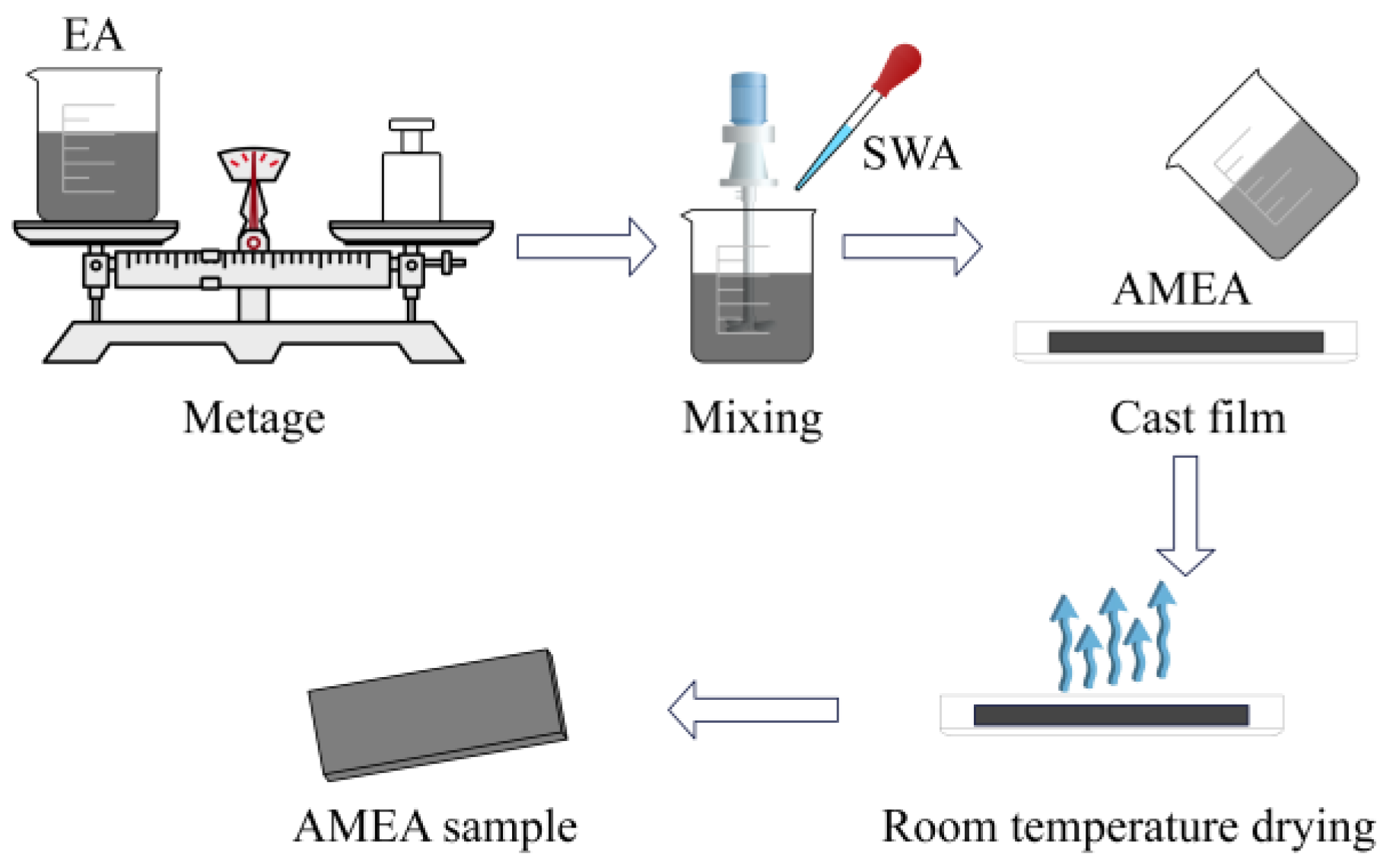
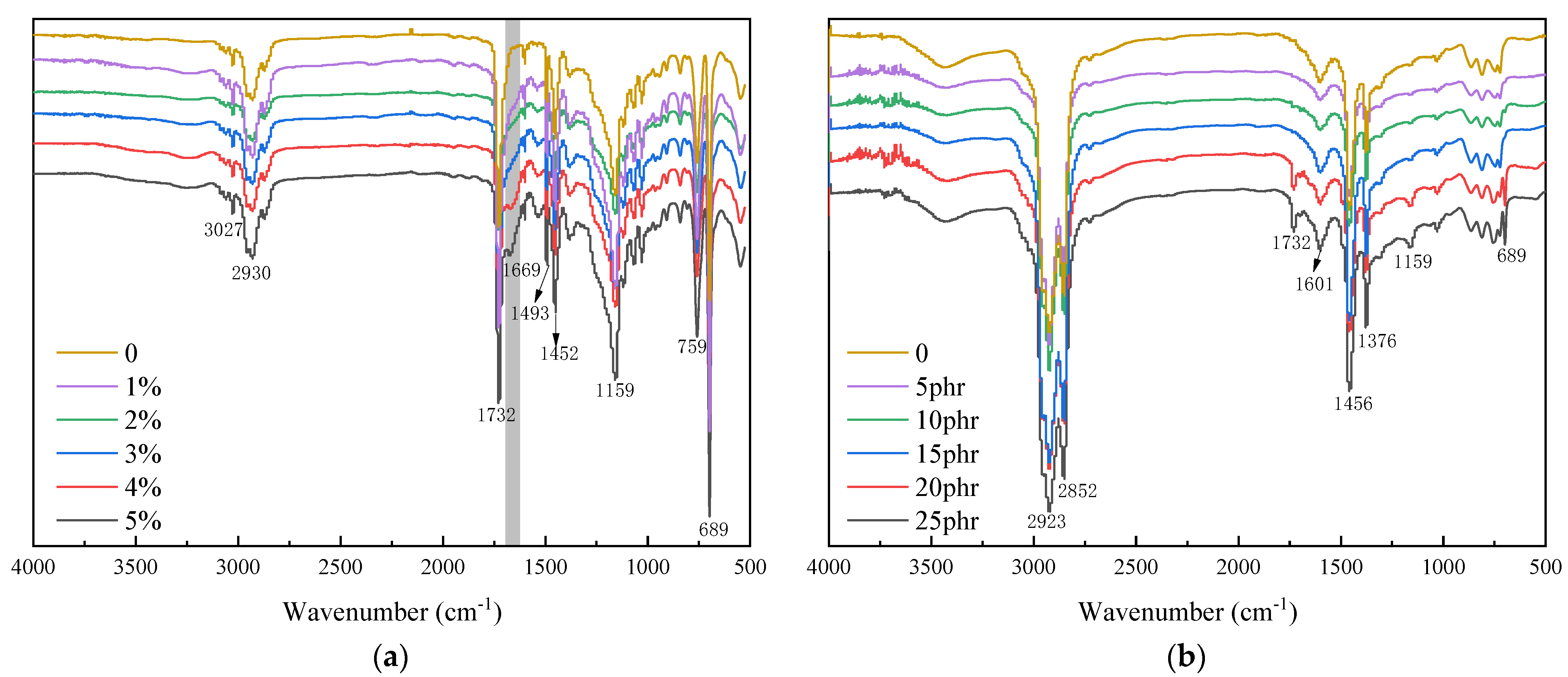
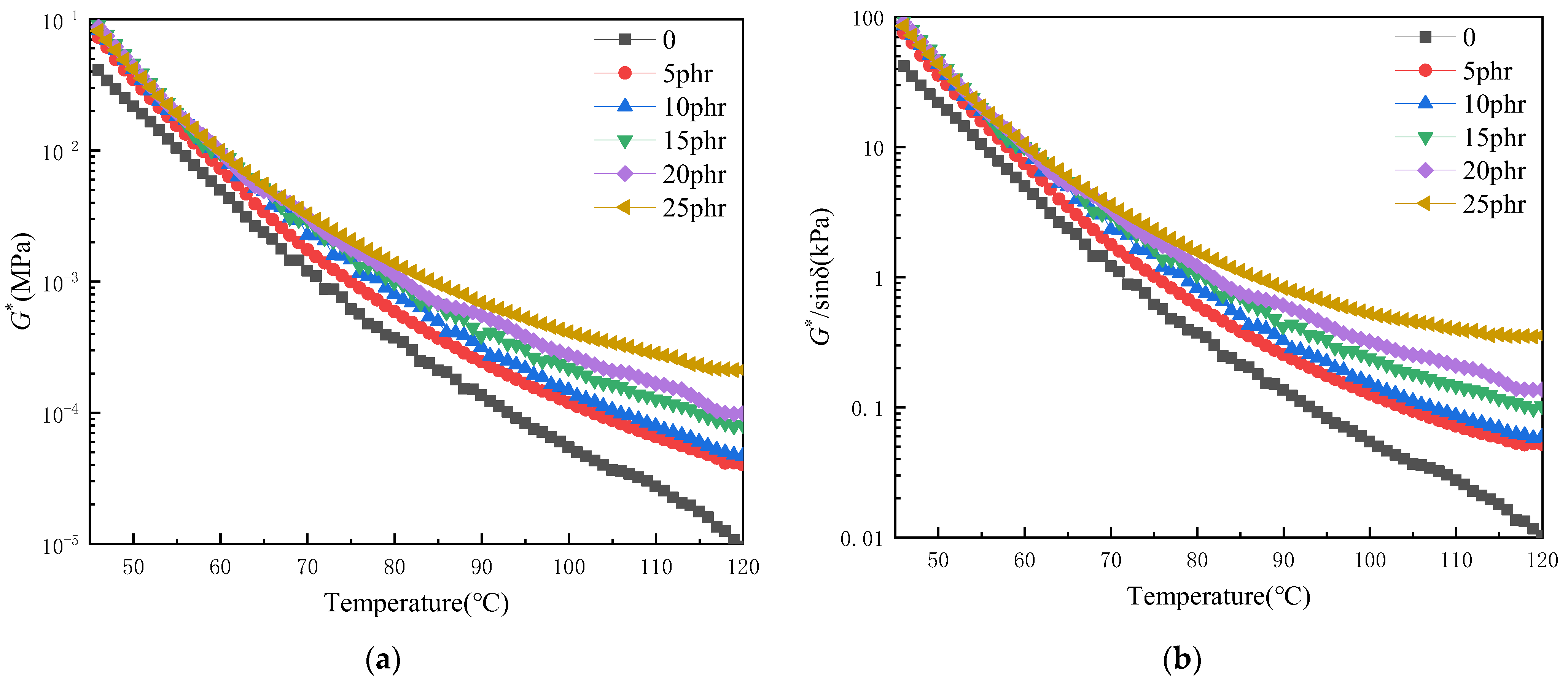

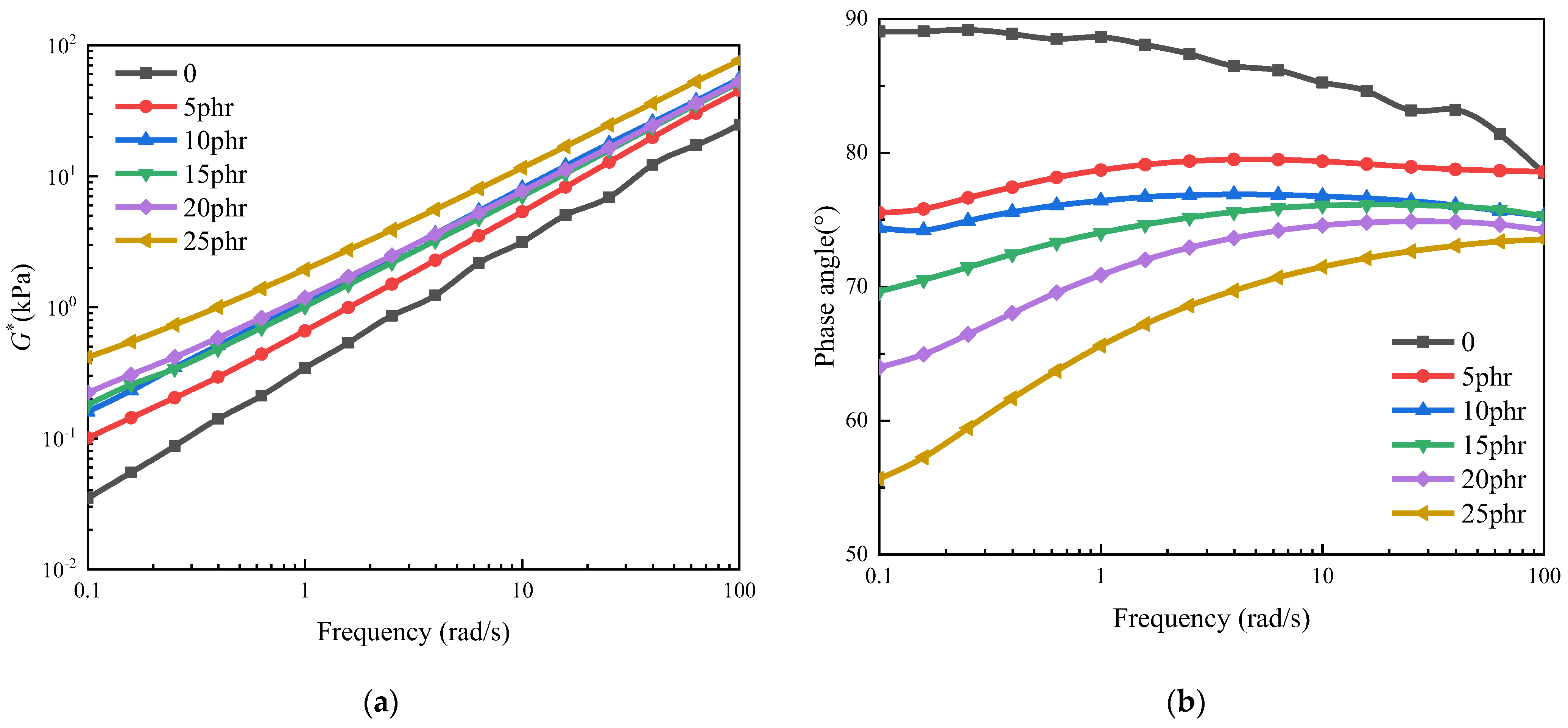


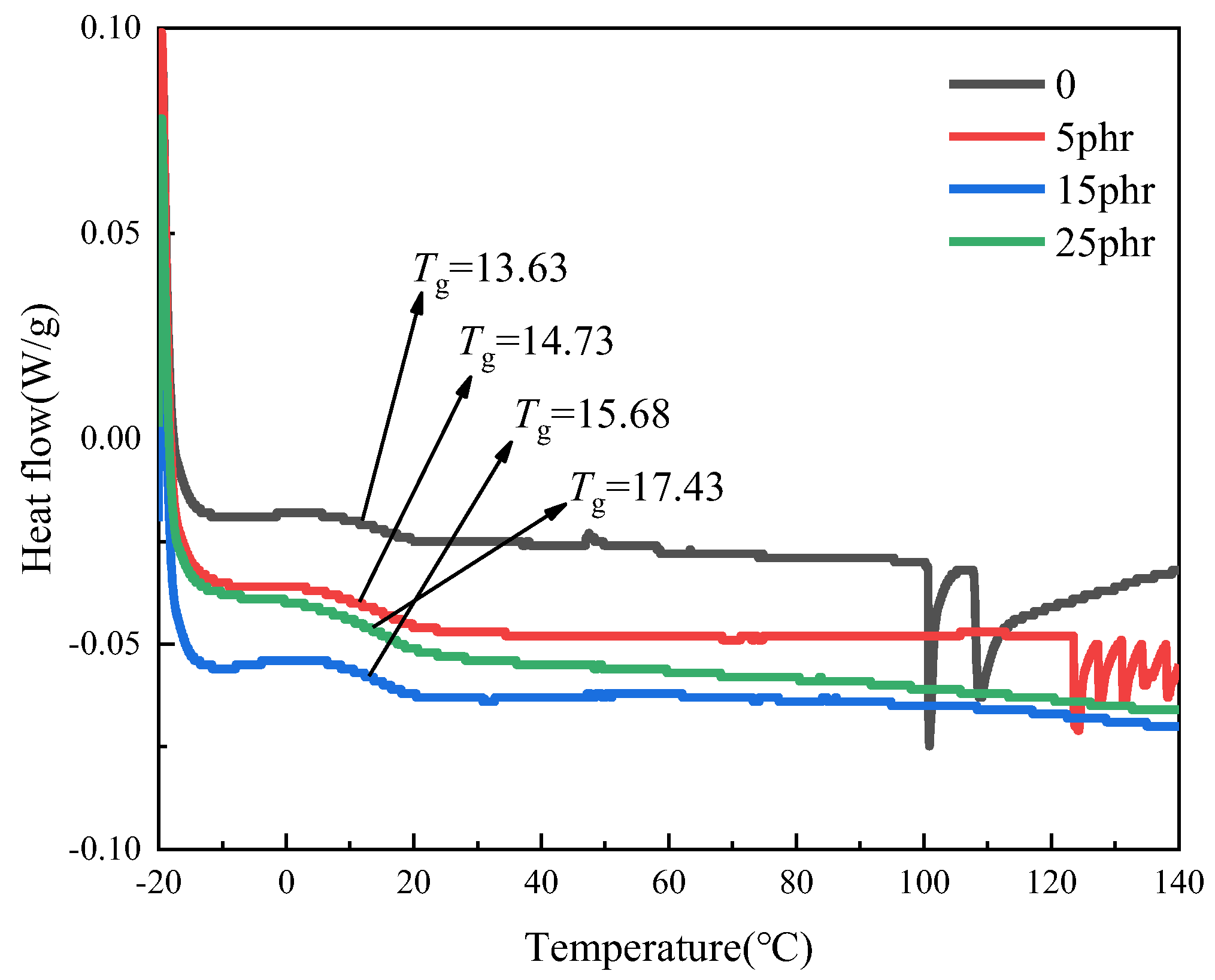



| Test Items | Unit | Technical Requirement | Test Result | Method | |
|---|---|---|---|---|---|
| Residue on sieve (1.18 mm sieve) | % | ≤0.1 | 0.04 | JTG E20 T0653 | |
| Storage stability | 1 d | % | ≤1 | 0.4 | JTG E20 T0655 |
| 5 d | % | ≤5 | 2.1 | ||
| Sample performance | Content | % | ≥60 | 63.5 | JTG E20 T0651 |
| Penetration (25 °C) | 0.1 mm | 40~100 | 64.5 | JTG E20 T0604 | |
| Ductility (10 °C) | cm | ≥10 | 12.6 | JTG E20 T0605 | |
| Softening point | °C | ≥50 | 50.0 | JTG E20 T0606 | |
| Mixing Amount (phr) | Solid Content (%) | Softening Point (°C) | Penetration (0.1 mm) | 10 °C Ductility (cm) |
|---|---|---|---|---|
| 0 | 63.5 | 50.0 | 64.5 | 12.6 |
| 5 | 62.4 | 56.8 | 45.5 | 6.7 |
| 10 | 61.1 | 59.0 | 40.7 | 4.2 |
| 15 | 60.1 | 62.3 | 37.6 | 3.0 |
| 20 | 58.3 | 64.5 | 32.3 | 2.5 |
| 25 | 57.5 | 73.2 | 26.8 | 2.1 |
Disclaimer/Publisher’s Note: The statements, opinions and data contained in all publications are solely those of the individual author(s) and contributor(s) and not of MDPI and/or the editor(s). MDPI and/or the editor(s) disclaim responsibility for any injury to people or property resulting from any ideas, methods, instructions or products referred to in the content. |
© 2025 by the authors. Licensee MDPI, Basel, Switzerland. This article is an open access article distributed under the terms and conditions of the Creative Commons Attribution (CC BY) license (https://creativecommons.org/licenses/by/4.0/).
Share and Cite
Xu, J.; He, Z.; Li, H.; Tang, S.; Wang, J.; Dang, J.; Li, Y. Self-Crosslinking Waterborne Acrylate Modified Emulsified Asphalt via DAAM-ADH: A Dual-Enhanced Solution for Pavement Performance. Coatings 2025, 15, 420. https://doi.org/10.3390/coatings15040420
Xu J, He Z, Li H, Tang S, Wang J, Dang J, Li Y. Self-Crosslinking Waterborne Acrylate Modified Emulsified Asphalt via DAAM-ADH: A Dual-Enhanced Solution for Pavement Performance. Coatings. 2025; 15(4):420. https://doi.org/10.3390/coatings15040420
Chicago/Turabian StyleXu, Jianhui, Zhaoyi He, Haiying Li, Shutong Tang, Jie Wang, Jing Dang, and Yuanyuan Li. 2025. "Self-Crosslinking Waterborne Acrylate Modified Emulsified Asphalt via DAAM-ADH: A Dual-Enhanced Solution for Pavement Performance" Coatings 15, no. 4: 420. https://doi.org/10.3390/coatings15040420
APA StyleXu, J., He, Z., Li, H., Tang, S., Wang, J., Dang, J., & Li, Y. (2025). Self-Crosslinking Waterborne Acrylate Modified Emulsified Asphalt via DAAM-ADH: A Dual-Enhanced Solution for Pavement Performance. Coatings, 15(4), 420. https://doi.org/10.3390/coatings15040420




